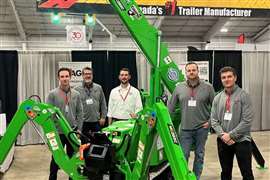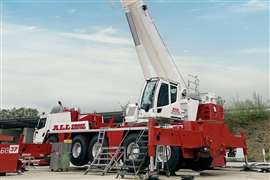South America sees huge growth for the crane industry
13 August 2010

South America has not been affected by the global financial crisis to the same extent as many other world regions and prospects for crane users are escalating.
IHS Global Insight forecasts a 4% growth in construction activity throughout South America in 2010 and, according to Harald Böhaker at Austrian loader crane manufacturer Palfinger, "South America is experiencing a historical economical change never seen before."
In Brazil, for example, development minister Miguel Jorge says the country will invest BRL 1.3 trillion ($ 735 billion) in the infrastructure, industry and construction sectors over the next three years. "We have macroeconomic, political and institutional stability. We have quickly overcome the effects of the international financial crisis and have returned to a path of sustainable growth," Jorge says, "Our economy is expected to grow by 6% to 6.5% during 2010, which makes this a great time to invest in Brazil."
Opportunities
That is not to say the last couple of years have been an easy ride for manufacturers producing in and exporting to South America. Böhaker says the global financial crisis of 2008/2009 created a temporary glitch in the market leading to a drop in order value of some 38%. The recovery started in the last quarter of 2009, thanks to renewed confidence from attractive interest rates on long term finance deals and governmental tax incentives, mainly in Brazil, Chile and Peru, Böhaker adds.
Allen Kadow, director marketing, Latin America, Manitowoc Cranes, explains how lifting opportunities will come from fabrication yards, shipyards, the assembly of large components and upgrades to petrochemical plants, as well as the assembly and disassembly of mining equipment and infrastructure work, mining operations and energy projects, including thermo-electric plants and wind turbines. "As mining continues to expand in the region, there will be more cranes needed in mines to support operations there," says Kadow.
Wolfgang Beringer at Liebherr-Werk Ehinghen in Germany agrees, "These countries have a great need to modernise and expand their infrastructure to satisfy their growing demands and allow their industries to develop in their countries and reach competitiveness abroad."
Cranes
From a machine perspective, Beringer says Liebherr's LTM all terrains are in high demand across the capacity range, particularly 4- and 5-axle machines and upwards for infrastructure projects and mining industry machine support.
Crawler cranes of all sizes are also popular, adds Beringer, particularly in the heavy lift division for the continent's rapidly expanding wind turbine parks and refineries.
Interest also lies in the truck crane and boom truck sector, significantly from manufacturers based in the nearby USA. Manitex International recently secured $4 million in boom truck orders, many of them from South America. "[It is] a region that is experiencing increased demand from multiple sectors," says Scott Rolston, Manitex senior vice president, sales and marketing.
Echoing this experience, Terex Cranes hosted 150 customers during the launch of its 26 US ton BT 26106 Super Stinger boom truck at its plant in Waverly, Iowa, USA. The company says visitors came from six countries to see its range of boom trucks, truck cranes and rough terrains, including Argentina, Brazil, Chile and Peru, as well as Canada and USA.
Kadow confirms these experiences. He says the most popular cranes in the continent are 40, 60 and 90 tonne capacity Grove rough terrains. "This is mainly because they are economical and very versatile. They are especially helpful in mining applications where they are used to assemble and disassemble and maintain mining equipment.
"We are also starting to see interest in 400 tonne and larger Manitowoc crawler cranes, which are being used in the very large energy development projects. Also, five- and six-axle Grove all terrain cranes are used throughout the region as well. They have excellent capacity and also the ability to move easily from job to job."
Heavy lift
The expanding crawler crane market in South America is a particularly important factor in this developing market, according to David Rodrigues commercial director at rental giant Makro. "This is due to the increase of infrastructure work in the country. Makro has invested in crawler cranes, composed of 750, 600, 400 and 250 tonnes." The company also invested in a 1,200 tonne capacity Liebherr LTM 11200-9.1 wheeled mobile crane.
Another of its acquisitions, the Liebherr LR 1600 crawler, was acquired with the wind energy sector in mind - a huge growth area (see box). "Large hoisting is fundamental for a competitive advantage in the Latin American market," adds Rodrigues.
Demonstrating the requirement for heavy lift services in the continent, international heavy lifting and transport specialist ALE has opened a new office in Bogota, Colombia. It supports UK-headquartered ALE's existing presence in Argentina, Brazil and Venezuela. It was opened at the same time as another new office in Morocco, Africa.
"The new Moroccan and Colombian offices allow us to provide a more complete service in these two key geographic areas," commented Javier Martinez, ALE executive director. "By having a dedicated point of contact we will be able to provide an enhanced level of service to our clients operating in these regions."
Country focus
Looking at individual countries more closely, the Brazilian economy continues to accelerate with an estimated GDP growth of 6.2% in 2010 and forecast 4.5% on average for 2011-2014, says Böhaker.
Independent infrastructure and industrial association Associação Brasileira da Infraestrutura e Indústrias de Base (ABDIB) forecasts Brazil will need to invest more than BRL 800 billion (US$ 452 billion) in the next five years to be ready for the 2014 FIFA Football World Cup and the 2016 Olympic Games it is hosting.
Paul Godoy, ABDIB chairman, says, "Brazil is fully qualified to host the two tournaments. Projects with long-term economic and financial feasibility will be attractive to the private sector, as they will leave a legacy of growth and development for Brazilian society. Meeting the construction demands of the two tournaments will be a challenge but, also, a unique opportunity for Brazil."
Beringer adds a note of caution, "Exporting to Brazil has been characterised by bureaucracy, complex import regulations and increasing environmental regulations. The key for success is to know how to deal with these requirements and to maintain flexibility and perseverance but, nowadays, this applies to all markets."
Despite this the opportunities are there for the taking. For example, the Growth Acceleration Programme (PAC), although politically controversial, is a major investment plan from the Brazilian government designed to generate $503.9 billion for construction, sanitation, energy and transport. One related project is the extensive São Paulo Metro, now under construction.
Then there is the planned Belo Monte hydroelectric power plant and further investments in refinery and petrochemical plants, as well as the vast mining sector.
Tadano's distributor in the country, TDB do Brasil, sums up this optimism. "Brazil has steel, gold, silver, emeralds, quartz, petroleum oil, methanol, and others, and only a very few of these have been explored, until now," says Marcio G de Campos, managing director.
"Brazil not only has natural resources but, most importantly, it has a future. We have a big territory, an enormous coast to develop harbours alongside, as well as roads and infrastructure jobs. We do not have earthquakes or typhoons and our weather is good. Our education is improving and there are no conflicts with neighbouring countries."
Expanding on the future of the crane industry, de Campos continues, "Due to enormous distances between the cities, the most popular cranes are truck mounted. They do not have the technology of all terrains and are quite easy to maintain anywhere in Brazil - particularly the ones assembled on Brazilian chassis. However, all types of cranes are required: all terrains, crawlers, rough terrains and others."
Strength
To further strengthen its presence in the continent Liebherr has established its own mobile and crawler crane division, Liebherr Chile, in Santiago. The sales and after sales service in Santiago is also supporting the manufacturer's activities in Peru, which is showing signs of being a major market, says the manufacturer.
Böhaker agrees, "Chile and Peru are also experiencing economic growth - mainly pulled by the mining industry, due to copper price increases and, most recently, in Chile by extraordinary investments for rebuilding as a consequence of the recent earthquakes."
Beringer adds that Chile is also seeing expansion from cement companies seeking to increase their production capacities. There is also huge investment in infrastructure in the country, with specific projects, including the port of Callao, Lima airport and hydroelectric development.
Kadow points to other markets, "Chile has been fairly stable in terms of demand over the past few years, and we expect it to continue into the near future. Colombia, however, has recently become an important market in South America. We also expect Peru to emerge as an important player in the region due to positive economic projections for this country, especially in the mining and energy development sectors."
Another country to keep an eye on is Ecuador, adds Kadow, "The oil industry in Ecuador is beginning to come alive again, and that has led to an increase in sales of cranes to the country."
Challenges
As with any region of the world, there are local regulations that create some challenges for a global manufacturer. Manitowoc's Kadow talks about the challenges faced in South America. "Axle-loading weights, for instance, vary globally, as well as regionally. In some countries, the restrictions are dictated by tonnes per axle, so you can just keep adding more axles to space out the weight. But in other areas, axle spacing is what is regulated, so that the loads are spread out - this is usually for bridge loading rules.
"So, you have different design priorities for different parts of the world. The answer to these issues is to remain as flexible as possible, while maintaining a basic crane design. Adding tag axles or dollies to carry the boom are both solutions to this problem.
"Another solution is to mount cranes on locally built chassis, which already satisfy local road regulations. This is what Manitowoc is doing in Brazil with its National Crane boom trucks, which are being mounted on local truck chassis."
De Campos adds a few words of warning; "As much as possible South America must avoid importing used cranes from abroad. South America imports [new] cranes of all types and sizes, but if it receives the used ones from Europe, USA or the Orient, it will discourage manufacturing in Brazil and the opportunities to open several factories will be postponed."
View from China
Kobe Jia Liu, general manager at Zoomlion Brazil, shares the optimism of his Western counterparts, citing Brazil, Chile, Peru, Colombia and Panama as the busiest countries in the continent. "Panama is [doing well] because of its canal enlarging," although he adds, "In the countries outside Brazil, mining is the main application. In Brazil, the main applications are in petrochemical."
Looking at the economy, Jia Liu says, "In the countries outside Brazil, the depressed economy has ceased, but we cannot clarify if there will be certain recovery. For Brazil, the market was down in the last 12 months, but did not decrease much. It is expected that the Brazil market will boom in the next two to three years."
This, Jia Liu forecasts, will result in a 20 to 30% increase in the heavy equipment industry during that period. The only issue of concern is local regulation. "In Brazil, the government increases the customs tax to protect the local manufacturers, which increases our price in the market and the cost to the end user."
Concerning cranes, Jia Liu adds, "In the countries outside Brazil, the most popular crane brand is Terex and Manitowoc. In Brazil, the most popular truck crane brands are XCMG and Zoomlion, as the price is relatively lower than other brands and, by the way, they do not provide the same machines.
"For crawler cranes, the most popular brands are Liebherr and Manitowoc, as they have been in the market for a long time."
Summing up, Jia Liu says Zoomlion's product in the 50 to 130 tonne capacity range is mainly aimed at countries outside Brazil, while its 30 and 70 tonne truck cranes are the two most popular in Brazil.






